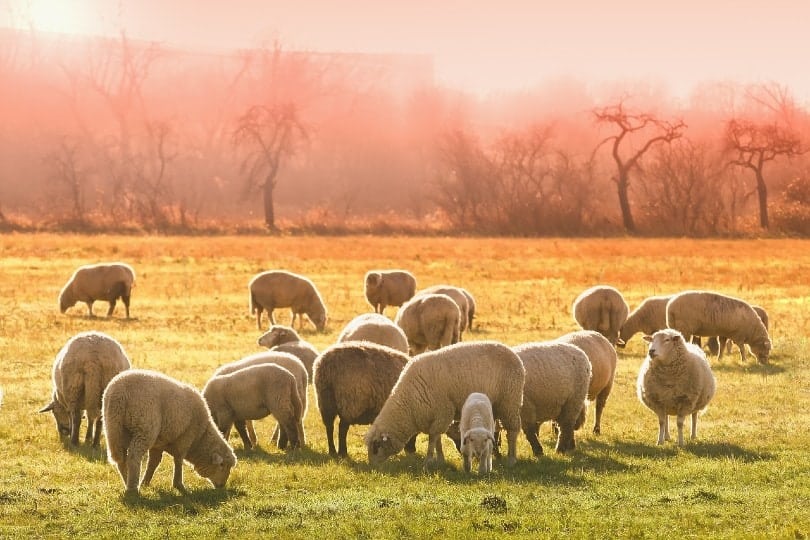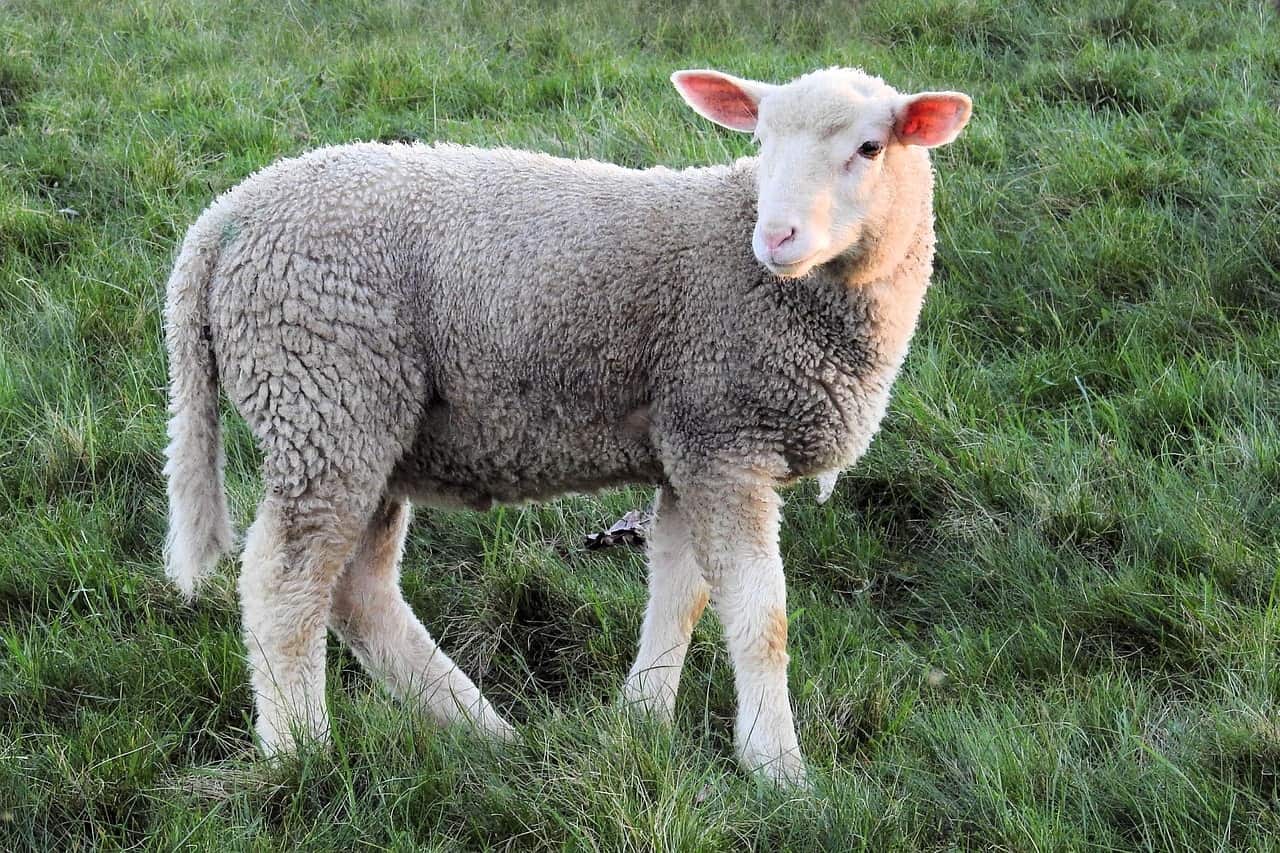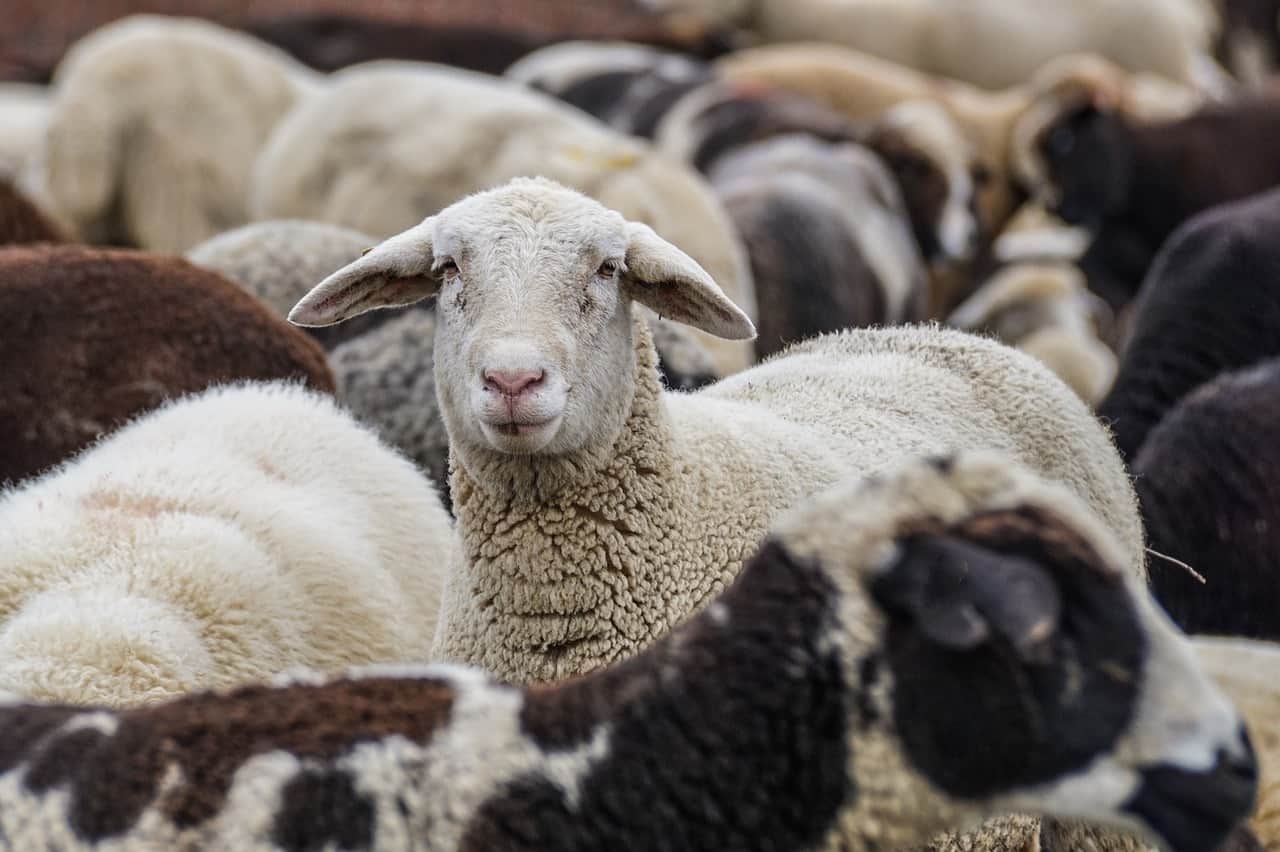Originally domesticated as a food source, sheep are now widely farmed for their meat, milk, skins, and wool. While mostly kept on larger-scale farming operations, some keep sheep for their smaller lifestyle blocks as homegrown food sources. Some others keep sheep as pets! Despite being one of the first animals to be domesticated, sheep aren’t very popular as pets.
While sheep can undoubtedly make good pets, they need more space than your regular pet animal as traditional livestock. One sheep needs at least a ½ acre of outdoor space to be happy. If kept in a barn, one ewe requires a minimum of 16 square feet of her own space.
These space requirements are pretty basic, and the amount of space needed will be influenced by a broad range of factors! Read on, and we’ll discuss the space requirements of keeping sheep in various settings.

Pasture Space
Most sheep are kept outside and grazed on grass pasture. This provides them the most natural environment and diet. They will have better overall health from the ventilation and exercise that outdoor living gives them. They will also express their natural behaviors by spending a majority of their time grazing and ruminating.
Pasture sheep also tend to have cleaner fleeces! In addition, sheep on pasture is the most popular as there are few costs to feed them. Supplementary feed may be required over the winter months, depending on the climate and the pasture.

Space Per Sheep
While sheep can live just fine in any space that is at least 15 square feet. If they are being pasture-fed, they will need at least half an acre per sheep. This follows the very general rule of a minimum of one acre for a pair of sheep.
One acre can service anywhere between two to ten sheep, depending on the condition of the grass. Factors that influence this include climate, soil quality, fertilizers, drainage, etc.
We’ve created this basic table for pasture space for sheep on a small scale. It is based on general requirements for sheep on average to good pasture.
| Pasture space needed for Sheep | |
| 1 Sheep | 0.5 acre |
| 2–10 Sheep | 1 acre |
| 10–50 Sheep | 5 acres |
| 100 Sheep | 10 acres |
Pasture Considerations
- Fencing: Keeping sheep outdoors on pasture has one vital requirement: good fences. Sheep are masters at finding any small gap to get out of, and if they can escape, they will! Good confinement is necessary to keep sheep safe out on pasture.
- Safety: Sheep are prey animals, so they can fall victim to predation if not in secure areas. This risk will depend on the area you live in, and what wild creatures also reside there.
- Lambing: Lambs are more vulnerable to poor weather conditions and can be at risk in inclement weather while very young. While lambs are usually born in spring, you may want to consider a barn space to put more at-risk young.
- Wintering: If you have a set number of sheep happily living and feeding off an area of pasture in spring, you also need to account for the winter months. There will be less feed available in winter. Either keep your land stocked lower, so there is enough grass to last your sheep the winter or provide supplementary feed when the grass is scarce.
- Rotation: If you rotate your sheep from paddock to paddock, you will increase the quality and quantity of your pasture. This way, you can keep a larger flock in a smaller space. It is okay to “set stock” your sheep in one place but keeping lower numbers will be better for them.

Barn Space
While sheep will do best on a natural pasture, keeping them in a barn can be sufficient with the proper care and husbandry. In locations with harsh climates, barn living may be required to keep sheep alive over rough winters.

Space Per Sheep
The space needed per sheep in a barn is much less than on pasture. No extra space is required for grazing as they will be fed dry foods such as hay or grain in a barn. They only need enough space so that they can move about comfortably and express their natural behaviors.
The average minimum space for a ewe is at least 16 square feet. A ewe with a lamb will require more space, as well as a ram. For the happiest barn sheep, an area of 20-25 square feet is recommended.
| Barn space needed per sheep (square ft.) | |
| Ewe | 16 |
| Ewe with lambs | 20 |
| Ram | 20 |
| Feeder lamb | 10 |
Barn Considerations
- Ventilation: A confined space like a barn will need adequate air circulation and slow. A build-up of debris in the air, such as fecal matter, dust, and dander, can cause respiratory illnesses in your sheep.
- Social Dynamics: Sheep do not like to be kept by themselves. They are very social animals! Keeping multiple sheep in a confined space, however, can pose challenges. If they do not get along, they will have nowhere to go. Give sheep extra space if they are housed in the same pens.
- Husbandry: Barn animals are a lot more work than those out on pasture. Confinement means there is a lot more cleaning for good health and hygiene. In addition, closer management is required to ensure they are happy and healthy.
- General Well-Being: Living exclusively in a barn will restrict sheep’s natural behaviors. They will not get the same kind of exercise or the health benefits of vitamin D and fresh air. While barns are a great, comfortable place for the winter or cold nights, it should not be a sheep’s whole life. You can’t beat outdoor time!

Housing Sheep: FAQ
Can a Sheep Be Kept Alone?
Technically, yes. But it is highly advised not to! Sheep are very social creatures. Psychology studies even concluded they can form a bond with each other and recognize individuals after years apart. When we think of sheep, we always imagine them in a flock because that’s an integral part of their lives.
Sheep can live in flocks of hundreds, very happily. Sheep should be kept with a minimum of one other sheep. They will feel most comfortable in a small group of four or five, giving them a sense of group safety.

Do Sheep Need Shelter?
The beautiful wool of a sheep does a stellar job at keeping them isolated from the elements. They can comfortably tolerate cold, wind, and rain while standing in the open. In worse weather or even the hot sun, they will seek shelter. In a pasture, this is usually under trees or cliffs. You can also provide them makeshift shelters for comfort.
Lambs cannot handle some of this rough weather and should be kept somewhere away from the elements if the weather is horrible. Management of your lambing season should match up with spring lambing.
Can Sheep Stay Outside in Winter?
Sheep are very hardy to the cold. They can even graze grass that is packed under the snow up to 12 inches under! Sheep can live outside in winter just fine. Good nutrition is the key to keeping them healthy in cold weather. Ensure they always have enough to eat and provide supplementary food if they cannot get to any grass.
Can I Keep a Sheep in My Backyard?
Depends on how big your backyard is! If you have a 1-acre backyard, then you may be able to house two sheep. Be aware of keeping sheep in residential zones as your local authorities may have restrictions around this. It is usually for the courtesy of your nearby neighbors, considering the smell and noise of such animals.
If you have space and it is legal, then sure, why not. Ensure you have excellent perimeter fencing and keep them out of the garden and weeded areas as many things may be toxic to them.

Final Thoughts
How much space do sheep need? There is no definitive answer to this particular question. There are a lot of factors that will influence how many sheep can happily live in a space. If you follow the general guidelines and adjust from there, you can find your happy balance. If you are still unsure, start small. Keep just two sheep in a one-acre area. See how this ratio fares over winter when the grass is minimal, and if they thrive, you may be able to increase the amount of sheep in this space.
Featured Image Credit: 165106, Pixabay
